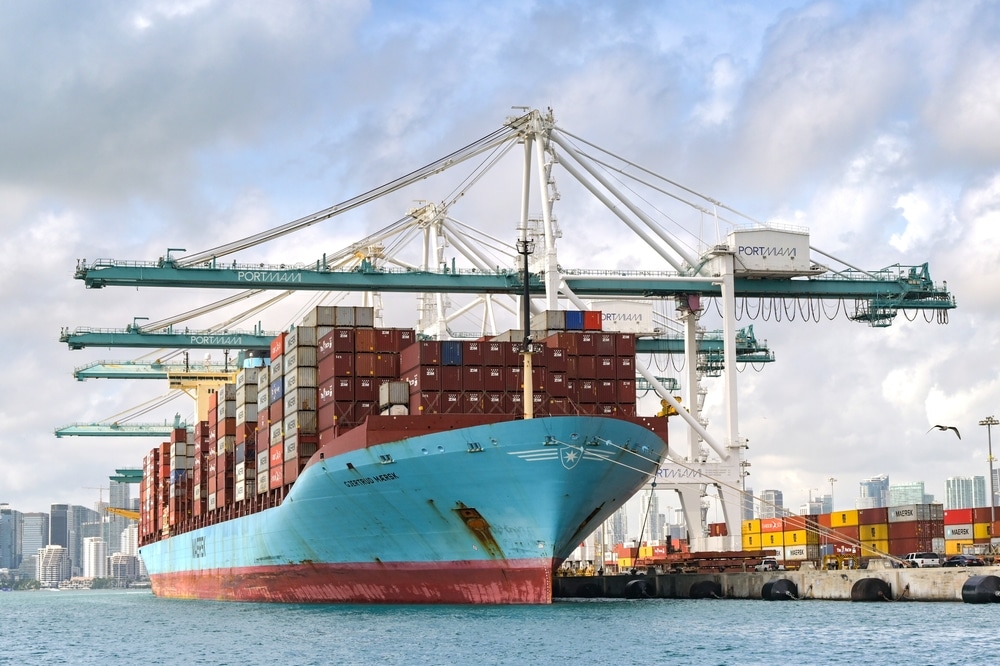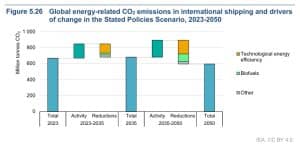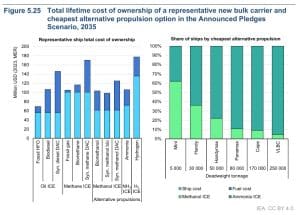The shipping industry is an integral part of international trade. Over the past 40 years, global maritime trade has increased 10X in value. Just like other transportation sectors aviation and auto, shipping also has some level of carbon emissions.
In the Announced Pledges Scenario (APS), shipping emissions could fall significantly. IEA predicts by 2035, emissions from international shipping may drop by nearly 60%, and by 2050, they could fall by more than 90%.
This shift is expected as the shipping industry adopts cleaner fuels like biofuels, ammonia, and methanol. By 2050, low-carbon fuels may power over 80% of global shipping.
The Two-Way Approach to Decarbonizing Shipping
Decarbonizing the shipping industry is crucial for meeting global emissions targets. Currently, two primary strategies are in place which are enhancing energy efficiency and transitioning to low-emissions fuels. These approaches offer complementary benefits and can significantly reduce greenhouse gas (GHG) emissions.
Boosting Energy Efficiency in Shipping
One of the simplest operational measures is “slow steaming,” which involves reducing the average speed of ships. This practice doesn’t require modifications to the vessels but can indirectly affect costs. While slow steaming can lower overall fuel consumption, it may also increase operational expenses due to a need for more ships to maintain the same shipping capacity. This is particularly significant for sectors relying on just-in-time delivery systems.
Many technologies to improve energy efficiency are already available. New regulations like the Carbon Intensity Index (CII) require ships to lower their emissions over time, encouraging both new ships and retrofits to adopt energy-saving features.
There are a variety of technical measures that can be implemented to improve a ship’s fuel efficiency. Some examples are:
- Rigid Sails and Rotor Sails: Using wind for propulsion can reduce fuel usage.
- Waste Heat Recovery: Capturing and reusing heat from the engine improves overall efficiency.
- Anti-Fouling Hull Coatings: These prevent the growth of marine organisms on hulls, enhancing performance.
- Hull Optimization: Streamlining hull shapes minimizes water resistance, boosting speed and efficiency.
- Air Lubrication Systems: Generating microbubbles under the hull reduces friction.
Since 2010, the energy efficiency design of new ships has improved by 30-50%, driven by initiatives such as the International Maritime Organization’s (IMO) Energy Efficiency Design Index (EEDI). While current energy efficiency technologies are commercially available, they are not adopted very easily.
IEA predicts that efficiency gains of 5-10% or more by 2030 are feasible with highly advanced energy-efficient methods.
Now speaking about costs; the investment required for energy-efficient upgrades varies widely, but they often pay off through fuel savings. For instance, hull form optimization costs about $250,000 and can boost energy efficiency by 7.5%. More extensive retrofits, such as kite sails, can cost up to $1.2 million but offer smaller gains.
On the other hand, a new bulk carrier built with cutting-edge technology could be 40% more efficient than one built in 2023, while a retrofitted container ship could achieve about 30% in energy savings.
Transitioning to low-emission fuels
While improving energy efficiency is vital, it cannot completely eliminate emissions. This is why the shipping industry must also shift to low-emissions fuels to reach its net zero target.
Promising options for low-emission fuels are:
- Biodiesel: Can be used in existing diesel engines with little modification.
- Biomethane: A renewable alternative compatible with LNG engines.
These drop-in fuels have limitations based on the availability of sustainable biomass and high production costs. Despite being cheaper to implement, their overall costs may be higher due to market competition, particularly from aviation.
Advanced Alternatives: Methanol, Ammonia, and Hydrogen
- Methanol: Gaining popularity, methanol-fueled vessels are on the rise. In 2023, the first methanol-fueled container ship with a dual-fuel engine began operation. However, methanol requires modifications to ship engines and tanks.
- Ammonia: Although at a lower technology readiness level, ammonia offers a promising future due to its lack of carbon sourcing requirements. Approximately 20 ammonia-powered vessels are on order, with deliveries expected by 2026.
- Hydrogen: Over 20 hydrogen-fueled vessels are currently operational or planned. Safety guidelines for hydrogen usage in shipping are being developed, aligned with those for ammonia.
Shipping companies will need to consider the total cost of ownership, including fuel costs over a vessel’s lifespan when deciding which fuel technology to adopt. While methanol may be cost-effective for smaller vessels, ammonia tends to be more economical for larger ships.
Future Emissions Trajectories
International maritime shipping emissions have risen sharply in recent years, with a peak of 0.67 Gt CO2 in 2023, accounting for around 2% of global energy-related CO2 emissions. Emissions reductions will heavily depend on policies that promote faster efficiency gains and the switch to low-emission fuels.
In a scenario aligned with the latest IMO GHG Strategy, emissions could be reduced by more than 90% by 2050 compared to 2023 levels, primarily through low-emissions fuels like ammonia.
As shipping activity is projected to increase significantly, implementing low-emission strategies becomes imperative. By 2040, fossil fuel use in shipping could drop from nearly 100% to less than 30%.
However, the transition to low-emission shipping technologies will require substantial investment and regulatory support. Nonetheless, the potential for significant emissions reductions makes it significant for the industry.
Maersk Seals Long-Term Bio-Methanol Deal to Achieve Zero-Emission in Shipping
Danish shipping giant A.P. Moller–Maersk has entered a long-term agreement with China’s LONGi Green Energy Technology Co Ltd to purchase bio-methanol. This partnership strengthens Maersk’s commitment to zero-emission shipping. The press release revealed that,
It will meet Maersk’s methanol sustainability requirements including at least 65% reductions in GHG emissions on a lifecycle basis compared to fossil fuels of 94 g CO2e/MJ. The bio-methanol supply is set to begin in 2026.
Bio-fuels and e-methanol are emerging as go-to alternatives for major fossil fuel users, such as the shipping industry, due to their scalability and potential for sustainable production.
However, Maersk highlighted that the substantial cost difference between fossil fuels and greener options remains a significant barrier, challenging the shipping industry’s progress toward adopting alternative fuels and achieving net-zero targets.
Disclaimer: Source of all data and images from IEA Energy Technology Perspective 2024
MUST READ: Can Nuclear Power Propel Maritime into a Zero-Emission Era? Maersk to Explore Nuclear for Ships




